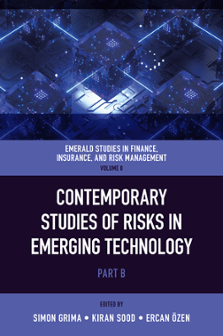
Index
Contemporary Studies of Risks in Emerging Technology, Part B
ISBN: 978-1-80455-567-5, eISBN: 978-1-80455-566-8
Publication date: 15 May 2023
Citation
(2023), "Index", Grima, S., Sood, K. and Özen, E. (Ed.) Contemporary Studies of Risks in Emerging Technology, Part B (Emerald Studies in Finance, Insurance, and Risk Management), Emerald Publishing Limited, Leeds, pp. 361-376. https://doi.org/10.1108/978-1-80455-566-820231020
Publisher
:Emerald Publishing Limited
Copyright © 2023 Simon Grima, Kiran Sood and Ercan Özen
INDEX
(see also Banking)
(see also Digitalisation)
- Prelims
- Chapter 1: Competitiveness as an Intangible Source of Knowledge, Organisational Culture, Processes, and Organisational Forms
- Chapter 2: Blockchain Technology for Internal Audit in Cyber Security Governance of Banking Sector in Turkey: A SWOT Analysis
- Chapter 3: Checking the Effectiveness of Blockchain Application in Fraud Detection with A Systematic Literature Review Approach
- Chapter 4: Analyse the Consumer Preferences and Purchases of Electric Vehicles Purchases and Developments
- Chapter 5: SDG Goal 9: Industry, Innovation and Infrastructure Accomplishment Through the Relationship Between Interactive Marketing and Destination Branding in the Tourism Sector
- Chapter 6: Role of Fintech for MSME and Start-up Ecosystem in Punjab, India
- Chapter 7: Using Text Mining in Financial Reporting: To Predict the Companies' Corporate Governance Qualifications
- Chapter 8: Role of Blockchain Technology in Creating Blue Ocean Strategy for Banking Products and Services
- Chapter 9: Global Trends in Transformation of Decision Support Systems: Case With VAT in SAP
- Chapter 10: Embracing Fintech Applications in the Banking Sector Vis-á-Vis Service Quality
- Chapter 11: Application of the Learning Process in Creative PC Games
- Chapter 12: ICT's Critical Role in Financial Inclusion: An Opportunity for India
- Chapter 13: Consumer Adoption of Technologies: A Mindset-Oriented Approach
- Chapter 14: Digital Economy Taxation Reform in Ukraine Under Conditions of Military Threats
- Chapter 15: Role of Multimedia Innovative Technology in Green Banking
- Chapter 16: E-Waste Management and Legal Concepts in India
- Chapter 17: Technological Upgradation in MSMEs: Moving Towards Innovation and Technology-Driven Marketing Research and Quality Management Standards
- Chapter 18: Impact of Information Technology on Audit Quality: European Listed Companies' Evidence
- Chapter 19: Performance Management and Artificial Intelligence: A Futuristic Conceptual Framework
- Index